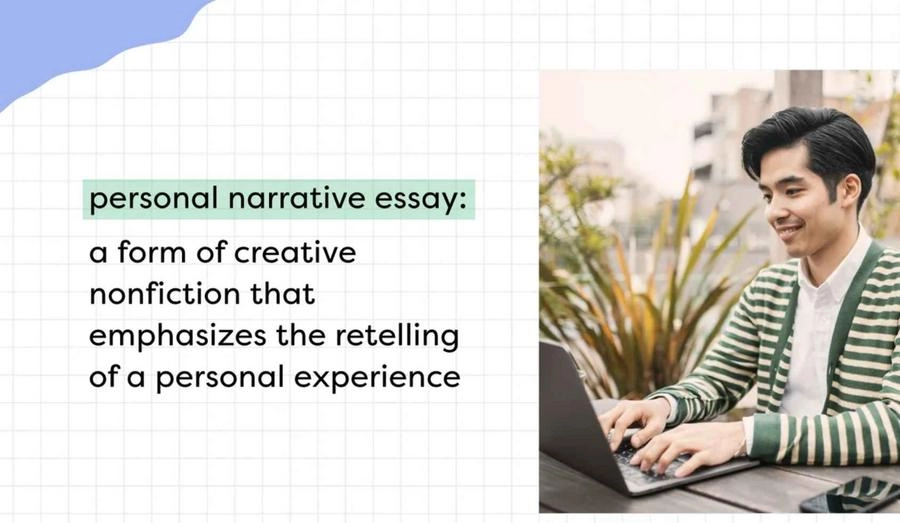A well-organized, gripping personal narrative essay can communicate personal knowledge, emotions, and insights. It prioritizes narrative and self-expression over research and citations, similar to other academic essays. To assist admissions personnel in understanding the applicant beyond academics and test scores, many college applications contain a personal narrative. A great story may show tenacity, personal development, and original ideas, setting applicants apart from hundreds.
Authenticity is key to writing personal narratives. Real, personal tales are preferred by readers, especially college admissions officers. First-person essays with “I” phrases make the narrative feel urgent and personal. Recounting an event is insufficient. The finest personal narratives contemplate why the experience was meaningful and how it influenced the writer's character or goals.
What is a personal narrative
A personal narrative is a type of writing that recounts the author's life. A personal narrative emphasizes storytelling, emotion, and reflection over analysis and argument of academic writing. A typical narrative arc includes an introduction, increasing action, climax, declining action, and resolution. This framework organizes events cleanly and compellingly, keeping the reader interested throughout.
Description is a hallmark of personal narratives. Writers must use sensory elements to vividly describe their experiences. Through movements, voice, and imagery, powerful narratives convey feelings and experiences. Rather than say "I was nervous," a writer can show hands shaking, a beating heart, or sweaty palms. It allows the writer to help the reader to experience the story.
Another key feature is reflection. A personal narrative includes what happened and why it mattered. The writer must explain how the event altered them, what they learned, or their future decisions. This reflection makes the article more powerful. Effective learning on how to write a personal narrative balances storytelling with reflection to create a compelling and meaningful essay.
How long should a personal narrative essay be?
A personal narrative’s length depends on its aim and the institution's or instructor's criteria. College application Common App essays are 500–650 words, long enough to tell a compelling story while being concise. To write your personal narrative requires balancing information and conciseness to make every word matter.
Personal narratives might be 500–1,000 words for academic or creative writing. Some professors may have particular restrictions, but a personal narrative should be long enough for rich information and significant contemplation. It's crucial to avoid digressions and wide descriptions. The tale should be well-structured so every paragraph supports the subject.
Word limits can be more flexible in professional or public venues, such as personal essays for blogs or periodicals. As before, clarity, engagement, and meaningful storytelling apply. The secret to writing effective personal narratives, regardless of length, is ensuring every word counts. To help you craft narratives successfully, organize essential events and reflections before writing to keep the essay structured and engaging.
How to write a personal narrative
Writing a personal narrative requires emotion, structure, and storytelling. Sometimes an outside perspective is all that matters. A writing service may increase ideas, structure, and clarity while maintaining authenticity. Many students use these services for editing and feedback rather than someone else writing for them. Checking a WritePaperFor.Me review can give insight into how such services support writers without taking away their voice.
Unlike essays, personal narratives are based on personal experiences, thoughts, and observations. This does not imply it lacks structure. Well-written personal narratives take the reader through a meaningful, emotional experience in a logical order. The following stages will explain how to write a personal narrative and assist authors in developing powerful stories.
Choose a meaningful topic
A powerful personal narrative is built on selecting the appropriate subject. The experience you chose has to be interesting for the reader as well as personally important. An excellent topic might be a little but significant moment that reveals your personality, values, or views, not always about a spectacular or life-changing incident.
Begin your search for the ideal topic by thinking back on events in your life that really stayed with you. Furthermore, take into account how a topic you choose fits the general idea you wish to get across. Insight into who you are as a person should be included in a personal narrative, which should also describe an incident. The subject should provide a chance for reflection so that the reader may grasp your ideas and feelings.
Create a strong introduction
The tone of the narrative is established at the introduction. The reader should be drawn in by a strong start and yearn to keep on reading. Starting with an interesting tale, a provocative question, or a vivid description of the environment, there are various successful approaches to start a personal narrative. For those unsure how to craft a compelling opening, looking at an EssayMarket.net review can provide insight into services that help refine introductions and create engaging beginnings without losing the writer’s unique voice.
One typical error is starting with too much background material or outlining everything ahead of time. Rather, attack the moment or feeling that will captivate the reader directly. To effectively write personal narratives, it's important to strike a balance between providing context and maintaining a sense of intrigue that keeps the reader engaged.
Build the narrative with vivid descriptions
The development of the narrative body comes once the introduction has been established. Using rich descriptions, sensory details, and powerful images to bring the experience to life will help a personal narrative to be successful. Furthermore, it is crucial to have a defined framework. Every paragraph should help the plot grow logically, guiding the occurrences.
Instead of describing, show what happened using actions, words, and feelings. Instead of writing "I was nervous before my performance," write "My hands trembled, my heart pounded in my chest, and my throat felt dry as I stepped onto the stage." This narrative enhances immersion and engagement.
Reflect on the experience
A personal narrative is about elucidating why the tale matters, not only about recounting events. The narrative has depth and significance because of reflection. Without thought, the essay turns from a meaningful examination of personal development or change into a set of occurrences.
Instead of being introduced at the end, reflection should be integrated throughout the narrative. Little reflective periods scattered throughout the essay help the events of the essay relate to the writer's ideas and feelings. Also, looking at a best essay writing service review can be useful for those who need guidance in structuring their reflections effectively.
Revise and edit thoroughly
In writing personal narratives, editing is a critical phase. A well-written article calls for several changes to improve the organization, clarity, and narrative effect. While following iterations should concentrate on refining sentence flow, reducing needless information, and strengthening descriptions, the initial draft should concentrate on getting the thoughts down.
Reading a personal narrative aloud is one of the easiest approaches to change it. Getting comments from mentors, professors, or classmates is another really smart tactic. One might find narrative strengths and shortcomings by looking from outside. Taking the time to write a personal narrative with careful revision ensures clarity, coherence, and a stronger emotional impact on the reader.
At last, guaranteeing uniqueness is one of the most important parts of changing a personal narrative. A major problem is plagiarism; hence, even in personal writing, it is important to maintain authenticity. Knowing how to avoid plagiarism includes making sure the tale is totally your own and that any allusions to outside sources correctly attribute them.
Examples of personal narrative essays
Varied kinds of personal narratives have varied uses. An essay for a college application seeks to wow admissions officials with the applicant's personality and experiences. An essay in creative writing gives artistic expression and narrative first priority. Usually used in applications for scholarships or professional programs, a personal statement centers on academic or career goals. Below are some examples of well-written essays for better comprehension.
College application essay
Among the most important kinds of personal narratives is a college application essay. It lets pupils highlight their own values, personalities, and goals. In order to understand the candidate beyond their academic background, admissions officers look for honesty, reflection, and a compelling narrative. The reader will be permanently changed if one can write a personal narrative that really represents their experiences and development.
"The sound of my grandmother’s old typewriter filled the quiet kitchen as she typed letters to family overseas. As a child, I watched in fascination, mimicking her movements on a broken keyboard. Years later, I found myself typing stories of my own, using words to bridge cultures and experiences. Moving between two worlds—one rooted in my family’s traditions, the other shaped by my education—I have learned to navigate complex identities. Writing has become my way of making sense of it all, allowing me to share perspectives that might otherwise go unheard."
Creative writing essay
A creative writing personal narrative allows for more imaginative storytelling, often incorporating poetic language or literary techniques.
"The moment my foot touched the stage, the world around me faded. The murmurs of the audience became distant echoes, and the harsh stage lights blurred into a golden haze. My heart pounded as I took a deep breath, steadying my shaking hands. I had spent weeks rehearsing for this moment, but suddenly, doubt crept in. What if I forgot my lines? What if my voice failed me? But as I spoke the first word, the fear melted away. I was no longer just myself — I was the character, the story, the voice that filled the room."
Personal statement
A personal statement is a structured reflection on achievements and aspirations.
"Growing up, I spent my summers in my grandfather’s workshop, where the scent of wood and oil filled the air. He taught me how to carve, measure with precision, and — most importantly — be patient. At the time, I didn’t realize that these skills extended beyond woodworking. Now, as I prepare for a future in engineering, I carry these lessons with me. The ability to create, problem-solve, and adapt has shaped the way I approach challenges, and I am eager to continue learning and building in ways that impact the world around me."
Conclusion
A personal narrative is about evoking emotions in the reader, not only about recounting events. The greatest ones leave a lasting impact, draw you in, let you view the world through someone else's eyes. Whether your writing is for a creative endeavor, a college application, or just a means of introspection, a compelling narrative requires significance above mere occurrences. Anyone may make a personal experience a narrative worth reading by selecting the appropriate moments, bringing them to life with details, and allowing time to consider why they matter.
FAQs
A personal narrative essay is an academic writing assignment that presents certain information from the writer’s point of view. The main goal of the paper is to share personal experience or reflection on a certain topic. In most cases, this type of paper is written in a form of an autobiography or memoir.
As the paper is classified as an academic project, it should be consistent, well-structured, and coherent. Divided the essay into the introduction, main body, and conclusion that can contribute to its scholarly value and keep it relevant.
Flexibility is one of the key features of personal narrative essay writing. However, striving to keep the audience interested in the theme, the writer should not make the paper too long. In most instances, the length of the paper will vary from 500 to 800 words.




